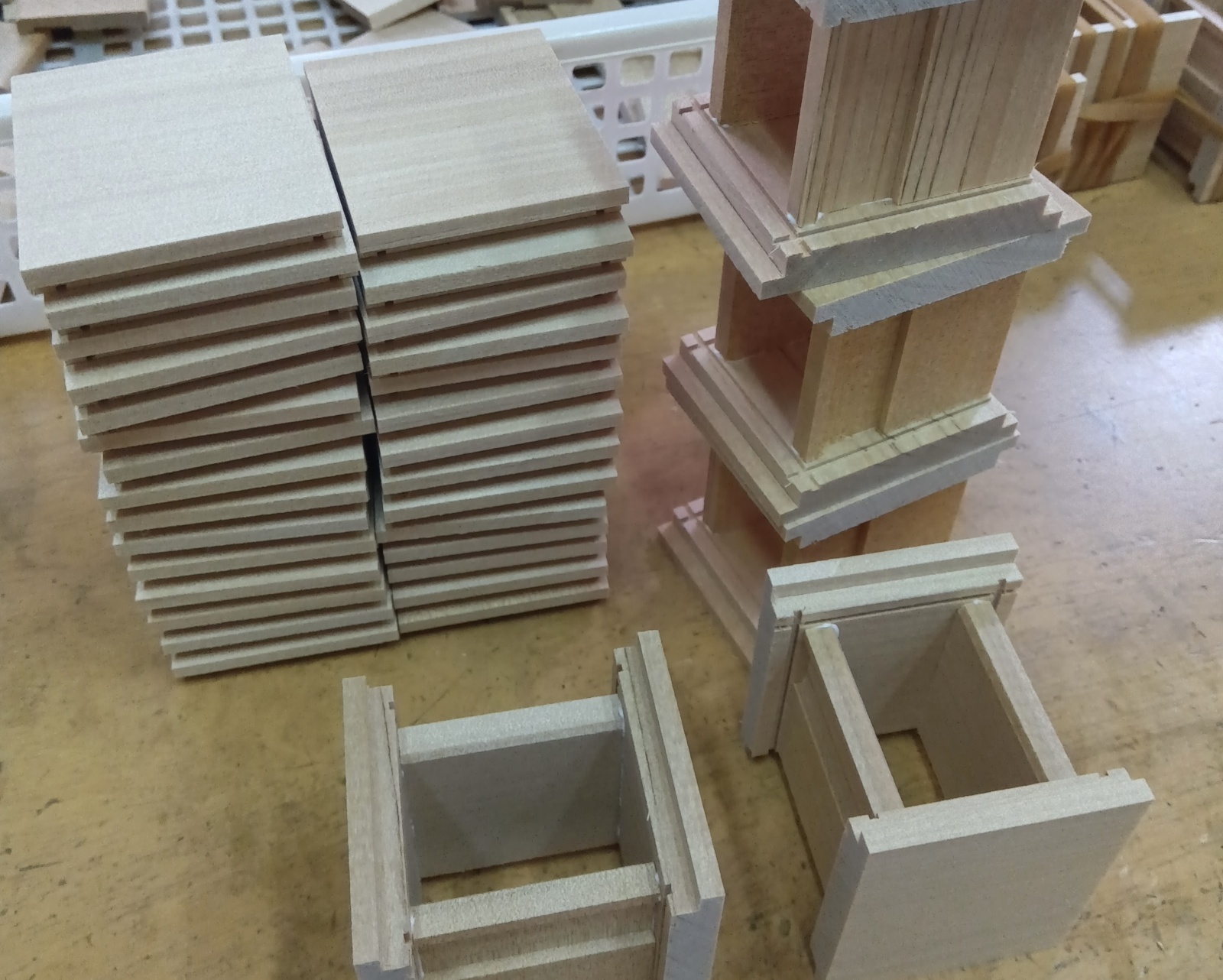Walnut wood panels
Today is still part of the Obon holidays in Japan, so I came to my workshop a bit later than usual.
The rain has stopped, but the sky is cloudy with occasional sunshine. Because the rain and strong winds yesterday scattered fallen leaves and branches around the workshop, I first cleaned up the area.
Since the humidity is still a little high, I started the day by attaching parts to the 4-sun boxes and assembling the frame panels for the 2-sun cube boxes. Right now, I’m working on three projects: 2-sun boxes, 4-sun boxes, and the 2-sun cube boxes I started yesterday.
The 2-sun box is the most on hold at the moment because the next step is attaching the important outer Aruki panels (moving panels). I want to wait until the humidity drops before doing that—especially because this time I’m using walnut wood, which needs extra care. Different woods have different “difficulty levels.”
Woods like magnolia and agathis are gentle and easy to work with, but walnut is a bit harder and more prone to warping. That’s why I carefully choose pieces with straight grain for the outer panels.
Right now, both the box bodies and the panels are stored together in a humidity-controlled case.
In Japan, there is a traditional way of dividing the year into 24 seasonal periods, called "Nijūshi Sekki".
Each period reflects subtle changes in the seasons. According to this calendar, we are now in the Risshū period, which lasts from August 7 to 22. It means “the beginning of autumn.”
You often hear Japanese people say, “It’s still hot, but according to the calendar, it’s autumn already.” The idea is that the day before Risshū is the peak of the summer heat, and from the next day, it gradually eases.
Maybe that’s true in some ways.
Yesterday I went to a department store, and summer clothes were already on sale, while many autumn clothes were on display. The period after Risshū is called Shosho, from around August 23 to September 6. During this time, it can still feel hot during the day, but mornings and evenings become cooler, and the nights grow longer. We often say “long autumn nights.” In any case, I’m looking forward to cooler weather soon. However, this Nijūshi Sekki calendar originally came from the Yellow River region in China, which has a colder climate. When it was brought to Japan, some of the seasonal timing didn’t quite match Japan’s climate, so a small difference is natural 😅
The rain has stopped, but the sky is cloudy with occasional sunshine. Because the rain and strong winds yesterday scattered fallen leaves and branches around the workshop, I first cleaned up the area.
Since the humidity is still a little high, I started the day by attaching parts to the 4-sun boxes and assembling the frame panels for the 2-sun cube boxes. Right now, I’m working on three projects: 2-sun boxes, 4-sun boxes, and the 2-sun cube boxes I started yesterday.
The 2-sun box is the most on hold at the moment because the next step is attaching the important outer Aruki panels (moving panels). I want to wait until the humidity drops before doing that—especially because this time I’m using walnut wood, which needs extra care. Different woods have different “difficulty levels.”
Woods like magnolia and agathis are gentle and easy to work with, but walnut is a bit harder and more prone to warping. That’s why I carefully choose pieces with straight grain for the outer panels.
Right now, both the box bodies and the panels are stored together in a humidity-controlled case.
In Japan, there is a traditional way of dividing the year into 24 seasonal periods, called "Nijūshi Sekki".
Each period reflects subtle changes in the seasons. According to this calendar, we are now in the Risshū period, which lasts from August 7 to 22. It means “the beginning of autumn.”
You often hear Japanese people say, “It’s still hot, but according to the calendar, it’s autumn already.” The idea is that the day before Risshū is the peak of the summer heat, and from the next day, it gradually eases.
Maybe that’s true in some ways.
Yesterday I went to a department store, and summer clothes were already on sale, while many autumn clothes were on display. The period after Risshū is called Shosho, from around August 23 to September 6. During this time, it can still feel hot during the day, but mornings and evenings become cooler, and the nights grow longer. We often say “long autumn nights.” In any case, I’m looking forward to cooler weather soon. However, this Nijūshi Sekki calendar originally came from the Yellow River region in China, which has a colder climate. When it was brought to Japan, some of the seasonal timing didn’t quite match Japan’s climate, so a small difference is natural 😅
